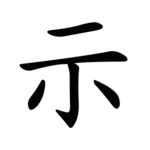Radical 113
Radical 113 (示 Unicode U+793A, compound form 礻 at U+793B, pinyin shì meaning "ancestor, veneration") is number 113 out of 214 Kangxi radicals. It is one of 23 radicals composed of five strokes (the compound form has four strokes). In the Kangxi Dictionary there are 213 characters (out of 49,030) to be found under this radical.
| 示 | ||
|---|---|---|
| ||
| 示 (U+793A) "ancestor, veneration" | ||
| Pinyin: | shì | |
| Bopomofo: | ㄕˋ | |
| Gwoyeu Romatzyh: | shyh | |
| Wade–Giles: | shih4 | |
| Cantonese Yale: | sih | |
| Jyutping: | si6 | |
| Kana: | シ shi しめす shimesu | |
| Kanji: | 示偏 shimesuhen ネ偏 nehen | |
| Hangul: | 보일 boil | |
| Sino-Korean: | 시 si | |
| Stroke order animation | ||
 | ||
The character 示 represents an altar or offering table, the top stroke depicting the offered goods. In the seal script the table has a T shape. Semantically, the sign suggests relation to anything connected with animism in traditional Chinese religion, such as 祭 "to sacrifice, to practice ancestor veneration", ultimately composed of the sign for meat 肉 and the sign for a hand 手 above the altar character, as it were iconographically expressing "hand placing meat on an altar". The sign 祟 for "spirit" originally referred to misfortune caused by malevolent spirits. In 禁 (jīn ) "to forbid, restrict, restrain", the 林 (lín ) above the radical has only phonetic significance (rebus writing). Similarly, 神 "spirit" has radical 113 plus 申 shēn as a phonetic marker. 祖 "ancestor" on the other hand has radical 113 plus 且, a pictograph of a stand with shelves for offerings to ancestors.
Some signs including the radical have no connection with spirits or animism and are placed in the category purely on formal grounds, such as 票 "ticket" which originally had radical 火 rather than 示.
The compound form 礻 always appears in the left half of characters.
Derived characters
| Strokes | Characters |
|---|---|
| + 0 | 示 礻 |
| + 1 | 礼 |
| + 2 | 礽 |
| + 3 | 社 礿 祀 祁 祂 祃 |
| + 4 | 祄 祅 祆 祇 祈 祉 祊 祋 祌 祍 祎 |
| + 5 | 祏 祐 祑 祒 祓 祔 祕 祖 祗 祘 祙 祚 祛 祜 祝 神 祟 祠 祡 祢 |
| + 6 | 祣 祤 祥 祦 祧 票 祩 祪 祫 祬 祭 祮 祯 |
| + 7 | 祰 祱 祲 祳 祴 祵 祶 祷 祸 |
| + 8 | 祹 祺 祻 祼 祽 祾 祿 禀 禁 禂 禃 禄 |
| + 9 | 禅 禆 禇 禈 禉 禊 禋 禌 禍 禎 福 禐 禑 禒 禓 禔 禕 禖 禗 禘 禙 |
| +10 | 禚 禛 禜 禝 禞 禟 禠 禡 禢 禣 |
| +11 | 禤 禥 禦 |
| +12 | 禧 禨 禩 禪 禫 |
| +13 | 禬 禭 禮 禯 |
| +14 | 禰 禱 |
| +15 | 禲 |
| +17 | 禳 禴 |
| +18 | 禵 |
| +19 | 禶 禷 |
Literature
- Fazzioli, Edoardo (1987). Chinese calligraphy : from pictograph to ideogram : the history of 214 essential Chinese/Japanese characters. calligraphy by Rebecca Hon Ko. New York: Abbeville Press. ISBN 0-89659-774-1.
- Leyi Li: “Tracing the Roots of Chinese Characters: 500 Cases”. Beijing 1993, ISBN 978-7-5619-0204-2
External links
See also
| Wikimedia Commons has media related to Radical 113. |
- Chinese numerals
- Ancestor Veneration in China
- 鬼